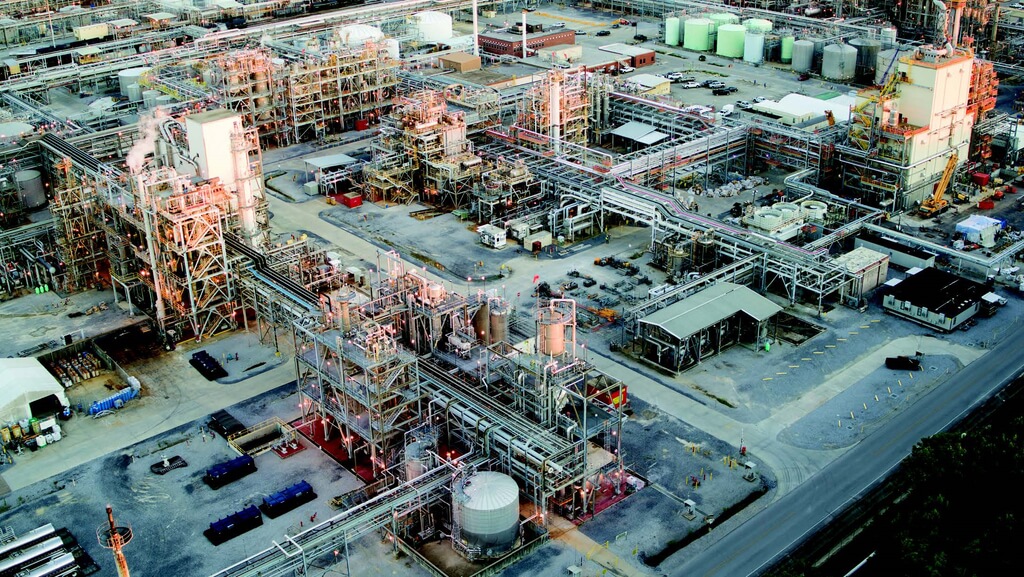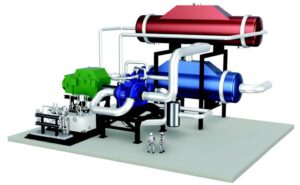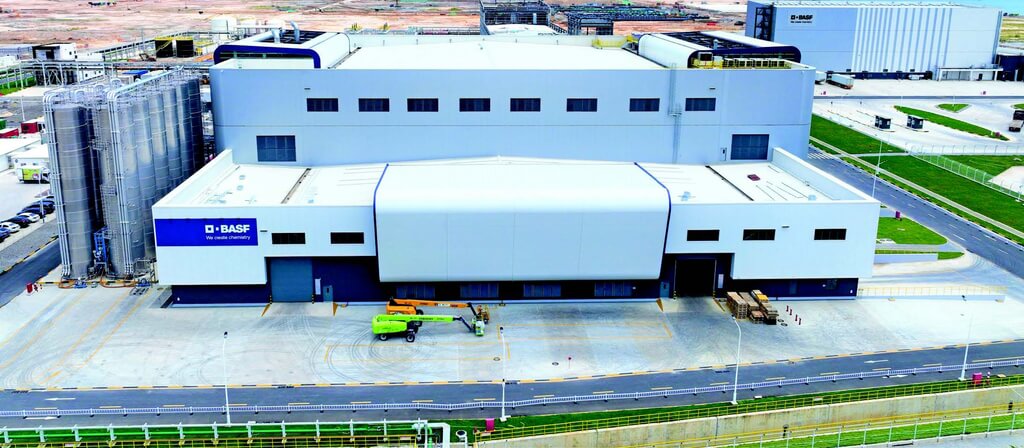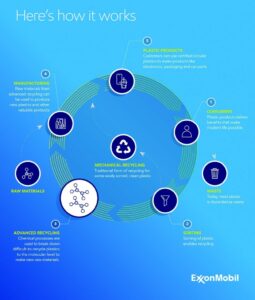Chevron Phillips Chemical is expanding its PAO business with the construction of a new unit in Beringen, Belgium.
There is a growing demand for chemical and petrochemical products, from agriculture and aerospace to automobiles. The Middle East, China, Europe and North America are bristling with new projects and expansions. But progress on recycling and reducing an environmental footprint is a major challenge.
By James Chater
Introductory
Do you suffer from recycling angst? Have you ever stood before a line of rubbish containers, unsure of which bin to use for any given object? Paper and plastic are easy to distinguish, but what about paper packaging with a plastic window? Or an object made of metal and plastic? And how can one be sure that the sorted objects will be recycled anyway, rather than consigned to a landfill? Chemicals and petrochemicals have transformed our lives. Plastics have been taking over from wood and metals, and one suspects that the revolution has only just begun. Self-repairing materials, self-sealing tyres, invisibility cloaks, ever more sophisticated recycling processes, bio-sourced and/or biodegradable products, new technology to store and recycle CO2, and more efficient catalysts: these are just some of the marvels being developed right now. However, these successes have brought significant challenges for the rapidly expanding petrochemicals industry: it will need to do more to reduce its environmental footprint. And despite the recent development of bio-sourced products, the industry is still hugely dependent on fossil fuels.

Projects
In a way, the industry is a victim of its own success. It is growing so rapidly that efforts to reduce its environmental footprint risk will almost inevitably fall short of what is required. Petrochemicals is a USD 37.5 billion industry (2021) projected to reach a value of USD 61.2 billion by 2028, with an annual growth rate of 8.5% between 2022 and 2028. Building (paints, coatings), transport and packaging are just some of the industries where demand is surging.
One of the major areas of growth is in North America, where competition has been enhanced by cheap shale gas and where some of the major players are headquartered. Among Chevron’s plans are the construction of a 1-hexene unit in Texas, a propylene unit in Baytown, Texas, and a polymers facility on the Gulf Coast. ExxonMobil has doubled its polypropylene production at Baton Rouge, and a large olefin facility using KBR technology is being contemplated.
In Europe, the focus is on Belgium. Here, Ineos is building a new olefin complex with an ethylene cracker, and Chevron is building an HDS unit and expanding its PAO capacity. The dominant player in Europe is BASF, which is modernising its chloroformate and acid chloride production at Ludwigshafen and building a new alkylethanolamines plant in Antwerp.

BASF is also active on other continents. With China’s Sinopec, the Verbund site in Nanjing, China, is being expanded, and its ester base stocks capacity in Jinshan is to be doubled; also, BASF gave final approval for the construction of a Verbund site in Zhanjiang. Elsewhere in Asia, Aramco is investing in a refinery with a steam cracker in South Korea.
The Middle East is also booming. Dow and Al-Hejailan Group have agreed to build a MDEA plant. Aramco, Sinopec and SABIC signed an agreement for the Gulei II refinery and cracker, and Aramco and TotalEnergies have agreed to build a new complex in Jubail. In anticipation of demand for equipment, Aramco has signed 59 new agreements with local manufacturers.
Bioplastics
If the petrochemicals industry is to become more sustainable, it must break free of its dependence on fossil fuels. However, there is little sign of this happening quickly. An obvious recourse is to rely on plastics that are bio-based or bio-sourced (i.e. wholly or partly derived from biomass); if these are also biodegradable or compostable, this is a bonus, though not all bio-sourced plastics biodegrade quickly. Currently, only 1% of plastics are bio-sourced, but the market is expected to grow over 10% per year between 2021 and 2030. The five largest producers are the USA, Germany, Brazil, and Canada.
Bio-sourced plastics are expensive compared to traditional materials because of the complex process used to convert corn or sugarcane. Apart from corn starch, other sources include milk, tapioca, and vegetable fats. Applications for PLA, one of the most common bio-sourced plastics, include plastic films, bottles, medical devices, and shrink wrap. Bio-sourced plastics can reduce greenhouse gas emissions and require less energy to process; however, disposal or recycling can be a problem, as if they are mingled with conventional plastic, they can slow down the rate at which these break down and are liable to emit methane, a greenhouse gas. There is thus an urgent need to develop alternatives, such as waste-to-energy projects. A related problem is a lack of infrastructure to process bio-based plastics. These need to be treated separately from traditional plastics to avoid contamination of the latter.

Circularity and recycling

This takes us into the realm of the circular economy, in which both recycling and waste-to-energy play a vital role. Petrochemical companies are developing a number of recycling projects. Prominent among these is Dow, which is building several facilities in the USA and Europe and has also expanded efforts into Africa, Nigeria, Egypt, and Guinea. ExxonMobil has also started up a facility in Irving, Texas, and recently completed a complex at Baytown, Texas.
Emissions reduction
There are obvious ways that companies can reduce their footprint with energy savings and environmentally friendly technology. For instance, BASF and MAN are collaborating to manufacture a large heat pump that will reduce natural gas consumption at the Ludwigshafen site. It will enable the production of steam using electricity from renewable energy.
Much work is being carried out to produce more efficient catalysts, and additive manufacturing is playing a role. BASF’s X3DTM will 3D-print catalysts featuring an open structure that reduces the pressure drop across the reactor and a high surface area, leading to higher performance.
Carbon recycling is another promising area. Carbon capture and storage is an established procedure, but many technologies need to be further tested or commercialised. For instance, a team at the University of Ox-ford has reverse-engineered jet engine fuel from CO2, by adding heat (350° Celsius) to citric acid, hydrogen, and a catalyst made of iron, manganese, and potassium to the carbon dioxide. Meanwhile, the Icelandic firm Carbon Recycling International (CRI) has just started to produce methanol from CO2 and hydrogen. Mineral Carbonation International (MCi) is pioneering a technology that would “lock away” CO2 by turning it into building blocks.
Aggressive environment for valves
Chemical and petrochemical plants contain some of the most severe environments known in industry, making extreme demands on materials. Corrosion resistance (especially pitting and crevice corrosion) and extreme heat are the two main factors determining material choice. Mechanical strength, good fabricability and weight saving are also major considerations. Stainless steel is standard in valves, storage tanks, heat exchangers, pressure vessels and reactors, cryogenic applications, and tubes, pipes and fittings.
Duplex and super duplex grades are often used when corrosion is severe and the temperatures do not require more heat-resistant nickel alloys. Sandvik has recently started to 3D-print components in Osprey® 2507 super duplex stainless steel, a material that can be used in chemical processing.
A super austenitic grade that could show promise in chemical and petrochemical plants is Sandvik’s Sanicro® 35, developed to bridge the gap between stainless steel and nickel alloys by achieving high performance, high strength, and superior corrosion resistance at a lower cost than nickel alloys.
Conclusion
Despite these advances, a great deal needs to be done if petrochemicals are to reduce their footprint. Only 9% of the world’s plastic is recycled, and to increase this will require an ambitious mobilisation effort involving governments at both national and local levels, industry, and private citizens. Excessive or ill-thought-out packaging will have to be eliminated. Perhaps citizens should be asked to bring reusable food containers and bottles to refill with products sold in bulk? At the same time, petrochemical companies should expect more of their profits be “recycled” to fund investment projects and clean-up efforts that mitigate the negative consequences of the expansion of their industry. In this respect, the prospect of a UN-sponsored treaty to end plastic pollution, to be signed in 2024, is a welcome development.
About this Featured Story
This Featured Story is an article from our Valve World Magazine, January/February 2023 issue. To read other featured stories and many more articles, subscribe to our print magazine. Available in both print and digital formats. DIGITAL MAGAZINE SUBSCRIPTIONS ARE NOW FREE.
“Every week we share a new Featured Story with our Valve World community. Join us and let’s share your Featured Story on Valve World online and in print.”




